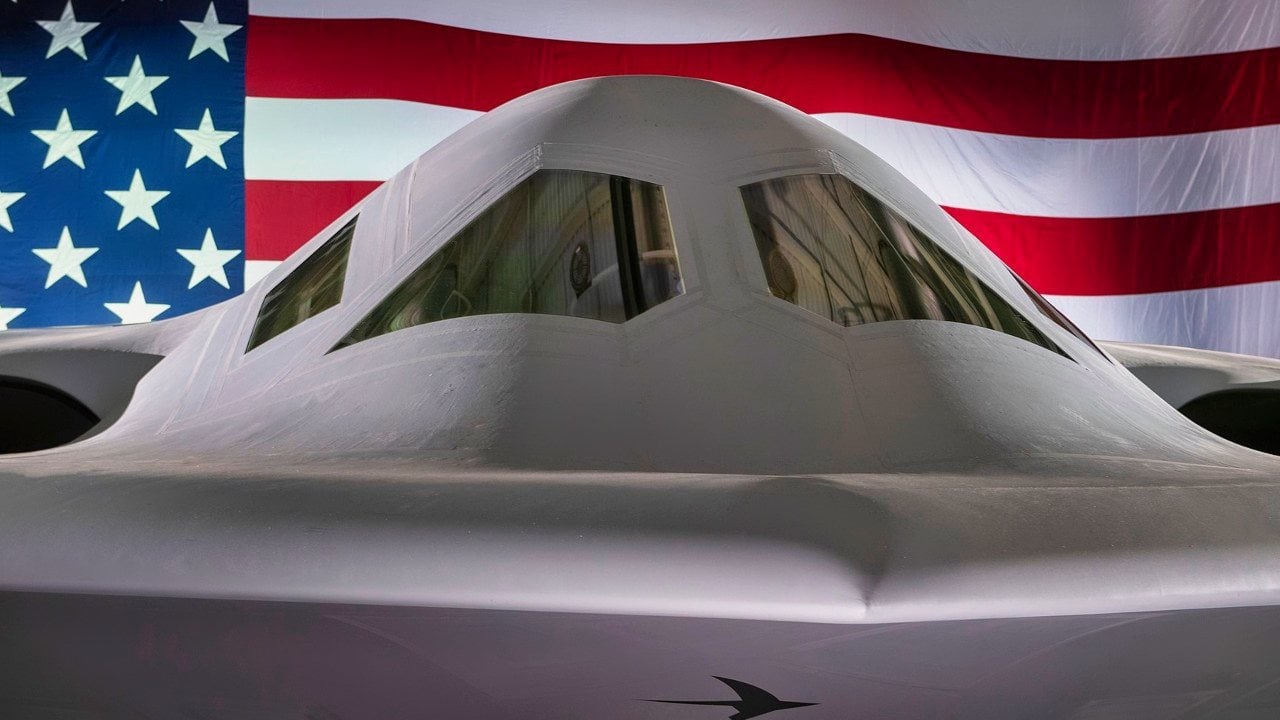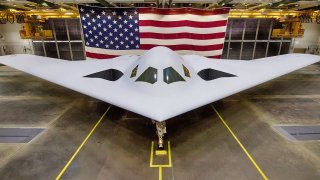B-21 Raider: Will the U.S. Air Force Build Enough of Them?
Experts have suggested that the U.S. Air Force needs 300 bombers to engage China in a war – but yet, as the B-21 Raider comes online, the service may not afford to maintain its older B-1 and B-2s flying. Thus, the bomber fleet will get smaller before it gets bigger.
The United States Air Force currently is just one of three nations to operate long-range strategic bombers. Its official operational fleet consists of just 131 aircraft – including 45 B-1B Lancers, 20 B-2 Spirits, and 58 B-52 Stratofortresses. However, it should be noted that a B-2 Spirit was damaged last year and shouldn't be considered operational, while the total number of B-52s that could be made ready to fly is 76.
That puts the number at 140 bombers that could in theory be ready should the United States find itself in an armed conflict that requires such aircraft.
That fact is notable as the U.S. Air Force is seeking a fleet of 100 B-21 Raiders that will replace the aging B-1s and B-2s and operate alongside the B-52s into the 2040s and perhaps even longer. At some point, the B-52 will also be retired, and that could leave the Air Force with just 100 bombers – and that's only if none are lost in accidents or otherwise grounded.
The Raider is one part of the U.S. Department of Defense's (DoD's) efforts to modernize all three legs of America's nuclear triad – which also silo-launched nuclear ballistic missiles and submarine-launched warheads. The bomber, which took its maiden flight in early November, was named for the 80 men who took part in the World War II "Doolittle Raid" on Tokyo in the spring of 1942. It was developed by Northrop Grumman – maker of the B-2 Spirit – via the aerospace firm's pioneering digital engineering practices and advanced manufacturing techniques together.
Six prototype aircraft are currently in various stages of production, and they are being built on the same lines, using the same tools and processes that will build the eventual production aircraft. This approach has enabled production engineers and technicians to capture lessons learned and apply them directly to follow-on aircraft, driving home a focus on repeatability, producibility, and quality.
In addition to building a bomber with state-of-the-art technology and capabilities, Air Force officials have further emphasized the focus on containing costs while simultaneously allowing for maximum flexibility. The B-21 has been noted for being designed with an open systems architecture that would enable rapid future capability integration to keep pace with the highly contested threat environment.
But Will 100 Be Enough?
Experts have suggested that the U.S. Air Force needs 300 bombers to engage China in a war – but yet, as the B-21 Raider comes online, the service may not afford to maintain its older B-1 and B-2s flying. Thus, the bomber fleet will get smaller before it gets bigger.

One factor is that the Air Force has simply received less money than the U.S. Army or U.S. Navy for decades and even with more funding, it will likely take time to ramp up the fleet again.
Colonel Mark Gunzinger, United States Air Force (Retired), who leads future concepts and capability assessments at the Mitchell Institute for Aerospace Studies, part of the Air & Space Forces Association industry group, called for the service to purchase upwards of 225 Raiders, which could operate along with the current fleet of B-1 Lancer, B-2 Spirit, and B-52 Stratofortress bombers now in service.
"More resources can buy back future risk and that’s what a more aggressive acquisition rate for the B-21 can do," Gunzinger told reporters in March ahead of the rollout of his Mitchell Institute report, "Understanding the B-21 Raider: America’s Deterrence Bomber."
"The continuing challenge will be to ensure the B-21 program is resourced to rapidly acquire an inventory that meets operational demands. This will require avoiding the same kind of budget driven decisions that eroded nearly all the service's advanced combat aircraft purchases since the Cold War, as in the case of the B-2, the F-22, and now the F-35A," the report stated.
The report further assessed the need to "rebuild a U.S. bomber force that has the capacity to simultaneously defeat Chinese aggression in the Indo-Pacific, credibly deter an opportunistic aggressor in another theater, and deter nuclear attacks on the United States—all requirements of the 2022 National Defense Strategy (NDS). Therefore, the U.S. Air Force should develop a total force of more than 300 bombers that includes at least 225 stealthy B-21s."
It is unlikely that Congress would approve such an acquisition.
At issue is the cost of the B-21 Raider, and each is expected to have a price tag of around $660 million – the most expensive aircraft ever built! One hundred of the aircraft would cost $66 billion! However, it could be suggested that the U.S. cannot afford not to build at least 100 and should consider doubling the order to deter China or other potential adversaries.
It Could Take Years to Build the First 100 B-21 Raider Stealth Bombers
Though the executives and shareholders at Northrop Grumman would no doubt welcome an order of 200 or more B-21 Raiders, the question is how long it might take to build that many aircraft.
As Air and Space Forces magazine reported in September, the Air Force could acquire just around 10 aircraft per year by the 2030s.
In other words, even if the money were made available, the Raider fleet would not become a reality for years to come.
Author Experience and Expertise
Peter Suciu is a Michigan-based writer. He has contributed to more than four dozen magazines, newspapers, and websites with over 3,200 published pieces over a twenty-year career in journalism. He regularly writes about military hardware, firearms history, cybersecurity, politics, and international affairs. Peter is also a Contributing Writer for Forbes and Clearance Jobs. You can follow him on Twitter: @PeterSuciu.
All images are Creative Commons.


